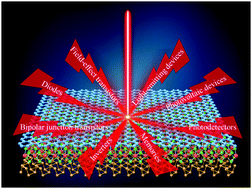Laser-assisted two dimensional material electronic and optoelectronic devices
Abstract
Two dimensional (2D) materials have generated enormous interest in various research fields in recent years due to their fascinating properties, such as atomic thickness, distinct structures and superior characteristics. In particular, electronic and optoelectronic devices based on 2D materials have been widely investigated, which is promising for the innovation of future nanoelectronics technology. Recently, the technique of laser processing 2D materials with the advantages of facile operation, versatility and low cost has been reported to enable the fabrication of diverse 2D material electronic and optoelectronic devices, such as field-effect transistors (FETs), p–n junction diodes, bipolar junction transistors (BJTs), inverters, memory devices, photodetectors, photovoltaic devices and light-emitting devices. Here, various interactions between lasers and 2D materials are introduced, such as direct writing processing, reduction, doping, phase transition engineering, thinning, oxidation and creating defects. The current advances in laser processing-assisted 2D material electronic and optoelectronic devices are reviewed. A comprehensive outlook on the future development of 2D material nanoelectronics/optoelectronics via laser processing is also presented.



 Please wait while we load your content...
Please wait while we load your content...